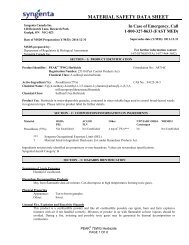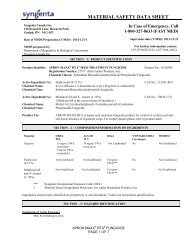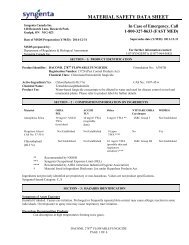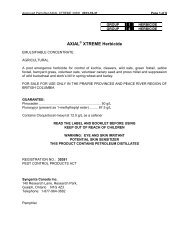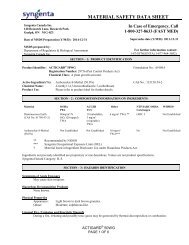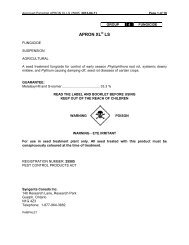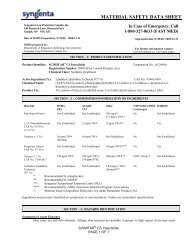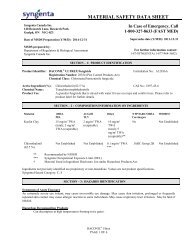Target MSDS - Syngenta Farm
Target MSDS - Syngenta Farm
Target MSDS - Syngenta Farm
- No tags were found...
Create successful ePaper yourself
Turn your PDF publications into a flip-book with our unique Google optimized e-Paper software.
MATERIAL SAFETY DATA SHEET<strong>Syngenta</strong> Canada Inc.140 Research Lane, Research ParkGuelph, ON N1G 4Z3Date of <strong>MSDS</strong> Preparation (Y/M/D): 2014-12-31In Case of Emergency, Call1-800-327-8633 (FAST MED)Supersedes date (Y/M/D): 2011-12-31<strong>MSDS</strong> prepared by:Department of Regulatory & Biological Assessment<strong>Syngenta</strong> Canada Inc.SECTION – 1: PRODUCT IDENTIFICATIONFor further information contact:1-87-SYNGENTA (1-877-964-3682)Product Identifier: TARGET ® LIQUID SYSTEMIC HerbicideFormulation No.: A14357ARegistration Number: 28028 (Pest Control Products Act)Chemical Classes: Phenoxy and benzoic derivative herbicide mixture.Active Ingredient (%): MCPA (23.3%) and Mecoprop-P [CMPP-P] (5.3%) and Dicamba (5.3%)CAS No.’s: 94-74-6 and 16484-77-8 and 1918-00-9.Chemical Name: A mixture of 4-chloro-2-methylphenoxyacetic acid, (2R)-2-(4-chloro-2-methylphenoxy)propanoicacid, and 3,6-dichloro-2-methoxybenzoic acid. All acids are present as amine salt.Product Use:Liquid herbicide for agricultural weed control. It is diluted with water prior to use. Please referto product label for further details.SECTION – 2 : COMPOSITION/INFORMATION ON INGREDIENTSMaterialMCPA Technical(23.3%)Mecoprop-PTechnical [CMPP-P](5.3%)OSHAPELACGIHTLVOtherNTP/IARC/OSHACarcinogenWHMIS†Not Established 10 mg/m³ Not Established No Not EstablishedNot Established Not Established Not Established No Not EstablishedDicamba Technical(5.3%)Not Established Not Established 10 mg/m³TWA***NoNot Established*** <strong>Syngenta</strong> Occupational Exposure Limit (OEL)† Material listed in Ingredient Disclosure List under Hazardous Products Act.Ingredients not precisely identified are proprietary or non-hazardous. Values are not product specifications.SECTION – 3: HAZARDS IDENTIFICATIONSymptoms of Acute ExposureHarmful if swallowed. May cause severe irritation to the eyes. May also cause irritation to the skin and mucousmembranes.Hazardous Decomposition ProductsCan decompose at high temperatures and form toxic gases.Physical PropertiesAppearance:Odour:Clear dark brown liquid.Mild, aromatic.TARGET ® HerbicidePAGE 1 OF 7
SECTION – 6: ACCIDENTAL RELEASE MEASURESPersonal Precautions: Make sure all personnel involved in the spill cleanup follow good industrial hygiene practices. A smallspill can be handled routinely. Wear suitable protective equipment and clothing as described in Section 8 and/or the productlabel.Procedures for dealing with release or spill: Control the spill at its source. Contain the spill to prevent from spreading orcontaminating soil or from entering sewage and drainage systems or any body of water. Clean up spills immediately,observing precautions outlined in Sections 7 and 8. Pump or scoop large amounts of liquid into a disposable container.Absorb remaining liquid or smaller spills with clay, sand or vermiculite. Scoop or sweep up material and place into adisposal container. Wash area with detergent and water. Pick up wash liquid with additional absorbent and place intocompatible disposal container. On soils, small amounts will naturally decompose. For large amounts, skim off the uppercontaminated layer and collect for disposal. Once all material is cleaned up and placed in a disposal container, sealcontainer and arrange for disposition. Spillages or uncontrolled discharges into watercourses must be reported to theappropriate regulatory body.SECTION – 7: HANDLING AND STORAGEHandling practices: KEEP OUT OF REACH OF CHILDREN. Prevent eating, drinking, tobacco use, and cosmeticapplication in areas where there is a potential for exposure to the material. Avoid breathing vapours or spray mist. Wear fullprotective clothing and equipment (see Section 8). After work, rinse gloves and remove protective equipment, and washhands thoroughly with soap and water after handling, and before eating, tobacco use, drinking, applying cosmetics or usingthe toilet. Wash contaminated clothing before re-use and separate from household laundry. Keep containers closed whennot in use. Protect product, wash or rinse water, and contaminated materials from uncontrolled release into theenvironment, or from access by animals, birds or unauthorized people.Appropriate storage practices/requirements: Store in original container only in a well-ventilated, cool, dry, secure area.Protect from heat, sparks and flame. Do not expose sealed containers to temperatures above 40 °C. Keep separate fromother products to prevent cross contamination. Rotate stock. Clean up spilled material immediately.National Fire Code classification: Not required.SECTION – 8: EXPOSURE CONTROLS/PERSONAL PROTECTIONApplicable control measures, including engineering controls: Ensure work areas have ventilation, containment, andprocedures sufficient to maintain airborne levels below the TLV. Warehouses, production area, parking lots and waste holdingfacilities must have adequate containment to prevent environmental contamination. Provide separate shower and eatingfacilities.THE FOLLOWING RECOMMENDATIONS FOR EXPOSURE CONTROLS/PERSONAL PROTECTION ARE INTENDEDFOR THE MANUFACTURE, FORMULATION, PACKAGING AND USE OF THIS PRODUCT.CONSULT THE PRODUCT LABEL FOR COMMERCIAL APPLICATIONS AND/OR ON-FARM APPLICATIONS.Personal protective equipment for each exposure route:General: Avoid breathing dust, vapours or aerosols. Avoid contact with eye, skin and clothing. Wash thoroughly after handlingand before eating, drinking, applying cosmetics or handling tobacco.INGESTION: Do not eat, drink, handle tobacco, or apply cosmetics in areas where there is a potential for exposure tothis material. Always wash thoroughly after handling.EYES: Where eye contact is likely, use chemical splash goggles. Facilities storing or utilizing this materialSKIN:should be equipped with an eyewash facility and a safety shower.Where contact is likely, wear chemical-resistant gloves (such as nitrile or butyl), coveralls, socks andchemical-resistant footwear. For overhead exposure, wear chemical-resistant headgear.INHALATION: A respirator is not normally required when handling this substance. Use process enclosures, local exhaustventilation, or other engineering controls to keep airborne levels below exposure limits. A NIOSHcertifiedcombination air-purifying respirator with an N, P, R or HE class filter and an organic vapourcartridge may be used under certain circumstances where airborne concentrations are expected to exceedexposure limits (e.g. emergency spills).TARGET ® HerbicidePAGE 3 OF 7
SECTION – 9: PHYSICAL AND CHEMICAL PROPERTIESAppearance: Clear dark brown liquid.Formulation Type: Water-based solution concentrate.Odour: Mild, aromatic.pH: 8.2 @ 25 o C..Vapour pressure and reference temperature:Dicamba acid: 1.25 x 10 -5 mmHg @ 25°CMCPA Technical Acid: 1.5 x 10 -6 mmHg @ 20°CMecoprop-P Technical (CMPP- P): < 7.5 x 10 -8 mmHg @ 20°CVapour density: Not available.Boiling point: Not available.Melting point: Not applicable.Freezing point: -5 o C.Specific gravity or density: 1.18 g/mL @ 20 o C.Evaporation Rate: Not available.Water/oil partition coefficient: Not available.Odour threshold: Not available.Viscosity: 43 mPas @ 25 o C (spindle #2 @ 30 rpm).Solubility in Water: Dicamba acid: >250 g/mLMCPA Technical Acid:>25 mg/LMecoprop-P Technical (CMPP- P): 860 mg/LSECTION – 10: STABILITY AND REACTIVITYChemical stability: Stable under normal use and storage conditions.Conditions to avoid: None known.Incompatibility with other materials: None known.Hazardous decomposition products: Can decompose at high temperatures forming toxic gases.Hazardous polymerization: Will not occur.SECTION – 11: TOXICOLOGICAL INFORMATIONAcute toxicity/Irritation Studies (Finished Product):Ingestion:Slightly AcutelyToxicOral (LD50 Female Rat):1,750 mg/kg body weightDermal:Inhalation:Eye Contact:Skin Contact:Skin Sensitization:Low AcuteToxicityDermal (LD50 Rat):Low AcuteToxicityInhalation (LC50 Rat):Moderately Irritating (Rabbit)Slightly Irritating (Rabbit)Sensitizing (Guinea Pig)> 5,000 mg/kg body weight> 2.57 mg/L air - 4 hoursReproductive/Developmental EffectsTechnical Active Ingredients:While MCPA does not have adverse effects on the reproductive capability ofthe rat, exposure to unacceptably high levels (i.e. considerably above theTLV) has been reported to cause birth defects in newborn rats. Dicamba is notteratogenic in animal studies, and does not affect the reproductive capabilityof rats. Information on the reproductive effects of CMPP-P is not available.TARGET ® HerbicidePAGE 4 OF 7
MCPA does not cause changes in hereditary material of microorganisms orcultured human cells in standard test procedures, but has been shown to causeweak effects in one insect species and either weak or no effects in other wholeanimal studies. CMPP-p also has weak effects in animals. Dicamba does notcause changes in the hereditary material of animals.Chronic/Subchronic Toxicity StudiesTechnical Active Ingredients:CarcinogenicityTechnical Active Ingredients:Other Toxicity Information:None.None known.Although some reports have suggested that phenoxy herbicides cause cancer,MCPA was determined not to cause cancer in rats in a study involving lifetimeexposure of rats to high doses of this compound. Exposure to CMPP-P ordicamba also did not cause cancer in animal studies.Toxicity of Other ComponentsThe acute toxicity test results reported in Section 11, above, for the finished product take into account any acutehazards related to the “other components” in the formulation.Other materials that show synergistic toxic effects together with the product: None known.<strong>Target</strong> OrgansActive IngredientsMCPA:Mecoprop-P:Dicamba:Inert IngredientsLiver, kidneys, spleen, thymus.Kidneys.Eyes, skin.Not Applicable.SECTION – 12: ECOLOGICAL INFORMATIONSummary of EffectsThe three active ingredients in <strong>Target</strong> Herbicide are active against broadleaved (dicot) weeds. If sufficientexposure occurs, broadleaved plants outside the intended area may be harmed, but the toxicity to other organismsis low. Based on the effects of the active ingredients, the product is expected to be practically nontoxic to bees,aquatic invertebrates, and fish, and only moderately toxic to birds.Eco-Acute ToxicityMCPA Technical:Green Algae 5-Day EC 50Bees LC 50 /EC 50 (Contact)Invertebrates (Water Flea) LC 50 /EC 50Fish (Trout) 96-hr LC 50 /EC 50Fish (Bluegill) 96-hr LC 50 /EC 50Birds (8-day Dietary - Bobwhite Quail) LC 50 /EC 50Birds (8-day Dietary - Mallard Duck) LC 50 /EC 50CMPP-P (Mecoprop-P) Technical:Bees LC 50 /EC 50 (contact)Invertebrates (Water Flea) LC 50 /EC 50 48 hrFish (Trout) LC 50 /EC 50 (96 hr)Fish (Bluegill) LC 50 /EC 50 (96 hr)Birds (8-day dietary - Bobwhite Quail) LC 50 /EC 50Birds (8-day dietary - Mallard Duck) LC 50 /EC 5046 ppm104 μg/bee> 100 ppm117 ppm97 ppm377 ppm>2000 ppm> 10 μg/bee> 100 ppm100 ppm> 100 ppm> 5,000 ppm> 5,620 ppmTARGET ® HerbicidePAGE 5 OF 7
Dicamba Technical:Green Algae 5-Day EC 50Bees LC 50 /EC 50 (Contact)Invertebrates (Water Flea) LC 50 /EC 50Fish (Trout) 96-hr LC 50 /EC 50Fish (Bluegill) 96-hr LC 50 /EC 50Bird (8-day Dietary - Bobwhite Quail) LC 50 /EC 50Bird (8-day Dietary - Mallard Duck) LC 50 /EC 50> 3.7 ppm> 100 μg/bee110 ppm135 ppm135 ppm> 10,000 ppm> 10,000 ppmEco-Chronic ToxicityDicambaTechnical:Invertebrates (Water Flea) 21-Day NOECFish (Trout) 21-Day NOECMCPA Technical:Invertebrates (Water Flea) 21-Day NOECFish (Trout) 21-Day NOECCMPP-P (Mecoprop-P) Technical:Invertebrates (Daphnia magna)21-Day Reproduction EC 50Fish (Rainbow Trout)21-Day NOECNot availableNot availableNot availableNot available22.7 mg/LNot AvailableEnvironmental Fate<strong>Target</strong> Herbicide is active when sprayed on foliage but has little or no residual activity after it has been in contactwith soil. The ingredients are degraded in plants or by micro-organisms in soil and water. None of the activeingredients in <strong>Target</strong> Herbicide has a potential to bioaccumulate. The ingredients are highly mobile in soil, butactual movement is limited by rapid degradation. Bulk material sinks in water (after 24 h test) and mixes withwater (water based).SECTION – 13: DISPOSAL CONSIDERATIONSWaste disposal information: Do not reuse empty containers unless they are specifically designed to be re-filled. Emptycontainer retains product residue. Dispose of empty containers in accordance with local regulations. Consult provincialenvironment ministry for advice on waste disposal. Industrial/commercial waste may be handled at licensed facilities only.Waste shipments must be securely packaged and properly labelled. Only licensed carriers may be used, and proper documentsmust accompany the shipment.SECTION – 14 : TRANSPORT INFORMATIONShipping information such as shipping classification:TRANSPORTATION OF DANGEROUS GOODS CLASSIFICATION - ROAD/RAILNot Regulated.SECTION – 15: REGULATORY INFORMATIONWHMIS classification for product: ExemptA statement that the <strong>MSDS</strong> has been prepared to meet WHMIS requirements, except for use of the 16 headings.This <strong>MSDS</strong> has been prepared in accordance with WHMIS requirements, but the data are presented under 16 headings.Other regulations; restrictions and prohibitionsPest Control Products (PCP) Act Registration No.: 28028TARGET ® HerbicidePAGE 6 OF 7
SECTION – 16: OTHER INFORMATIONThe information contained herein is offered only as a guide to the handling of this specific material and has been preparedin good faith by technically knowledgeable personnel. It is not intended to be all-inclusive and the manner and conditionsof use and handling may involve other and additional considerations. No warranty of any kind is given or implied and<strong>Syngenta</strong> will not be liable for any damages, losses, injuries or consequential damages which may result from the use of orreliance on any information contained herein. This Material Safety Data Sheet is valid for three years. This product is underthe jurisdiction of the Pest Control Products Act and is exempt from the requirements for a WHMIS compliant <strong>MSDS</strong>.Hazardous properties of all ingredients have been considered in the preparation of this <strong>MSDS</strong>. Read the entire <strong>MSDS</strong> forthe complete hazard evaluation of this product.Prepared by: <strong>Syngenta</strong> Canada Inc.1-87-SYNGENTA (1-877-964-3682)<strong>Syngenta</strong> Canada Inc. believes that the information and recommendations contained herein (including data and statements)are accurate as of the date thereof. NO WARRANTY OF FITNESS FOR ANY PARTICULAR PURPOSE, WARRANTYOF MERCHANTABILITY, OR ANY OTHER WARRANTY, EXPRESS OR IMPLIED, IS MADE CONCERNING THEINFORMATION PROVIDED HEREIN. The information provided herein relates to the specific product designated andmay not be valid where such product is used in combination with any other materials or in any process. Further, since theconditions and methods of use of the product and of the information referred to herein are beyond the control of <strong>Syngenta</strong>Canada Inc., <strong>Syngenta</strong> Canada Inc. expressly disclaims any and all liability as to any results obtained or arising from anyuse of the product or reliance on such information.TARGET ® is a trademark of a <strong>Syngenta</strong> Group Company.TARGET ® HerbicidePAGE 7 OF 7


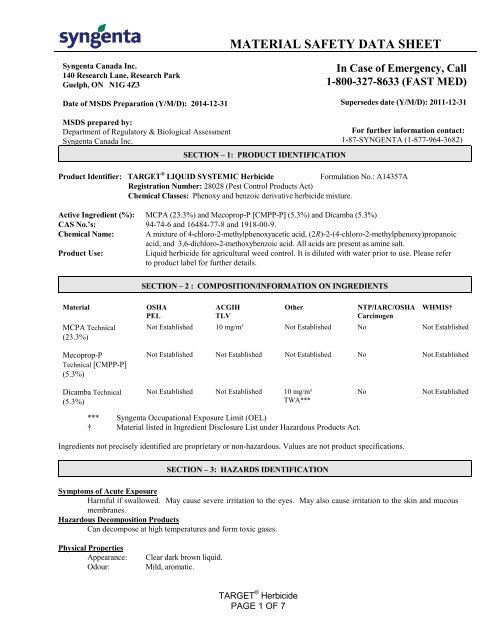
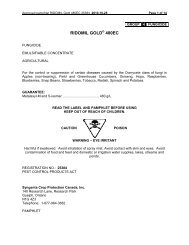
![gesagard 480sc [pamphlet] - Syngenta Crop Protection](https://img.yumpu.com/50945984/1/190x245/gesagard-480sc-pamphlet-syngenta-crop-protection.jpg?quality=85)
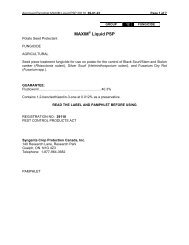
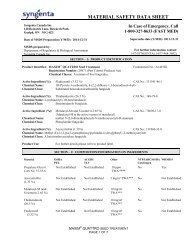
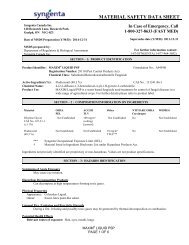
![ridomil Gold mz 68wp [bag] - Syngenta Farm](https://img.yumpu.com/49025229/1/190x245/ridomil-gold-mz-68wp-bag-syngenta-farm.jpg?quality=85)
